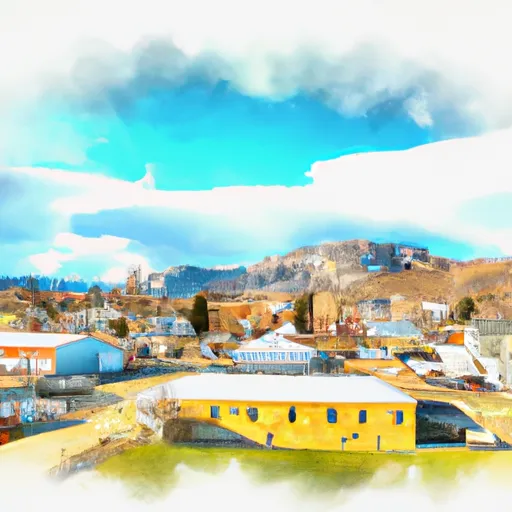-
 Snoflo Premium
Snoflo Premium
Get unlimited access to all our content
With no Ad interruptions! - Start Your Free Trial Login with existing account
Ringling
Eden Index
Climate
6.3
•
Recreation
1.4
•
Community
•
Safeguard
3.0/10

Ringling, Montana is a small town located in Meagher County, nestled in the central part of the state. The climate in Ringling is classified as a cool-summer continental climate, characterized by cold winters and warm summers. The average low temperature in January is around 10°F (-12°C), while the average high temperature in July is approximately 84°F (29°C). Precipitation is relatively evenly distributed throughout the year, with an annual average of around 16 inches (40 cm).
Ringling is surrounded by stunning natural landscapes, with notable hydrology constituents such as the Smith River and the Castle Mountains. The Smith River, known for its pristine beauty, offers excellent opportunities for fishing and boating. It is a popular destination for those seeking a serene and remote outdoor experience. The Castle Mountains, located south of Ringling, provide opportunities for camping, hiking, and wildlife viewing.
Outdoor recreation enthusiasts will also find numerous trails for hiking, biking, and horseback riding in the surrounding area. The diverse terrain and abundant wildlife make Ringling a haven for nature lovers. Whether exploring the mountains, fishing in the rivers, or simply enjoying the scenic beauty, Ringling offers an array of outdoor recreational opportunities for visitors and residents alike.
What is the Eden Index?
The Snoflo Eden Index serves as a comprehensive rating system for regions, evaluating their desirability through a holistic assessment of climate health, outdoor recreation opportunities, and natural disaster risk, acknowledging the profound impact of these factors on livability and well-being.
Climate Health Indicator (CHI): 6.3
Ringling receives approximately
383mm of rain per year,
with humidity levels near 69%
and air temperatures averaging around
5°C.
Ringling has a plant hardyness factor of
4, meaning
plants and agriculture in this region thrive during a short period during spring and early summer. Most
plants will die off during the colder winter months.
By considering the ideal temperature range, reliable water supplies, clean air, and stable seasonal rain or snowpacks, the Climate Health Indicator (CHI) underscores the significance of a healthy climate as the foundation for quality living.
A healthy climate is paramount for ensuring a high quality of life and livability in a region, fostering both physical well-being and environmental harmony. This can be characterized by ideal temperatures, reliable access to water supplies, clean air, and consistent seasonal rain or snowpacks.
Weather Forecast
Streamflow Conditions
Upper Missouri
Area Rivers
Upper Missouri
Snowpack Depths
Upper Missouri
Reservoir Storage Capacity
Upper Missouri
Groundwater Levels
Recreational Opportunity Index (ROI): 1.4
The Recreational Opportunity Index (ROI) recognizes the value of outdoor recreational options, such as parks, hiking trails, camping sites, and fishing spots, while acknowledging that climate plays a pivotal role in ensuring the comfort and consistency of these experiences.
Access to outdoor recreational opportunities, encompassing activities such as parks, hiking, camping, and fishing, is crucial for overall well-being, and the climate plays a pivotal role in enabling and enhancing these experiences, ensuring that individuals can engage in nature-based activities comfortably and consistently.
Camping Areas
| Campground | Campsites | Reservations | Toilets | Showers | Elevation |
|---|---|---|---|---|---|
| Battle Ridge | 13 | 6,402 ft | |||
| Newlan Creek Reservoir FAS | None | 5,286 ft | |||
| Grasshopper | 20 | 5,836 ft | |||
| Fairy Lake | 9 | 7,706 ft | |||
| Kings Hill | 25 | 7,422 ft | |||
| Moose Creek | 6 | 5,814 ft | |||
| Jumping Creek | 20 | 5,909 ft |
Nearby Ski Areas
Catastrophe Safeguard Index (CSI):
The Catastrophe Safeguard Index (CSI) recognizes that natural disaster risk, encompassing floods, fires, hurricanes, and tornadoes, can drastically affect safety and the overall appeal of an area.
The level of natural disaster risk in a region significantly affects safety and the overall livability, with climate change amplifying these risks by potentially increasing the frequency and intensity of events like floods, fires, hurricanes, and tornadoes, thereby posing substantial challenges to community resilience and well-being.
Community Resilience Indicator (CRI):
The Community Resilience Indicator (CRI) recognizes that education, healthcare, and socioeconomics are crucial to the well-being of a region. The CRI acknowledges the profound impact of these elements on residents' overall quality of life. By evaluating educational resources, healthcare accessibility, and economic inclusivity, the index captures the essential aspects that contribute to a thriving community, fostering resident satisfaction, equity, and social cohesion.

